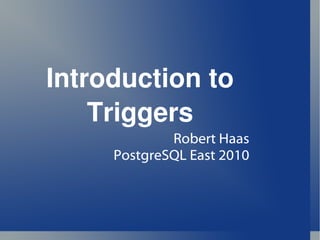Introduction to triggers
•Transferir como ODP, PDF•
1 gostou•3,158 visualizações
Denunciar
Compartilhar
Denunciar
Compartilhar

Recomendados
DML, DDL, DCL ,DRL/DQL and TCL Statements in SQL with ExamplesDML, DDL, DCL ,DRL/DQL and TCL Statements in SQL with Examples

DML, DDL, DCL ,DRL/DQL and TCL Statements in SQL with ExamplesLGS, GBHS&IC, University Of South-Asia, TARA-Technologies
Recomendados
DML, DDL, DCL ,DRL/DQL and TCL Statements in SQL with ExamplesDML, DDL, DCL ,DRL/DQL and TCL Statements in SQL with Examples

DML, DDL, DCL ,DRL/DQL and TCL Statements in SQL with ExamplesLGS, GBHS&IC, University Of South-Asia, TARA-Technologies
Mais conteúdo relacionado
Mais procurados
Mais procurados (20)
Destaque
Destaque (20)
Structured Query Language (SQL) - Lecture 5 - Introduction to Databases (1007...

Structured Query Language (SQL) - Lecture 5 - Introduction to Databases (1007...
Semelhante a Introduction to triggers
Semelhante a Introduction to triggers (20)
I am trying to change this code from STRUCTS to CLASSES, the members.pdf

I am trying to change this code from STRUCTS to CLASSES, the members.pdf
Mais de Command Prompt., Inc
Jeff Davis
I'll be showing how the extensible pieces of PostgreSQL fit together to give you the full power of native functionality -- including performance. These pieces, when combined, make PostgreSQL able to do almost anything you can imagine. A variety add-ons have been very successful in PostgreSQL merely by using this extensibility. Examples in this talk will range from PostGIS (a GIS extension for PostgreSQL) to DBI-Link (manage any data source accessible via perl DBI).PostgreSQL, Extensible to the Nth Degree: Functions, Languages, Types, Rules,...

PostgreSQL, Extensible to the Nth Degree: Functions, Languages, Types, Rules,...Command Prompt., Inc
Mais de Command Prompt., Inc (20)
Howdah - An Application using Pylons, PostgreSQL, Simpycity and Exceptable

Howdah - An Application using Pylons, PostgreSQL, Simpycity and Exceptable
PostgreSQL, Extensible to the Nth Degree: Functions, Languages, Types, Rules,...

PostgreSQL, Extensible to the Nth Degree: Functions, Languages, Types, Rules,...
Implementing the Future of PostgreSQL Clustering with Tungsten

Implementing the Future of PostgreSQL Clustering with Tungsten
Introduction to triggers
- 1. Introduction to Triggers Robert Haas PostgreSQL East 2010
- 3. Can fire on INSERT or UPDATE or DELETE or any combination.
- 4. Can fire once per statement or for every row.
- 5. Can fire BEFORE or AFTER the main operation.
- 6. Example #1: Compute full name CREATE TABLE person ( id serial PRIMARY KEY, first_name varchar not null, middle_name varchar not null, last_name varchar not null, full_name varchar not null ); CREATE OR REPLACE FUNCTION compute_person_full_name() RETURNS trigger AS $$ BEGIN NEW.full_name := NEW.first_name || CASE WHEN NEW.middle_name = '' THEN '' ELSE ' ' || NEW.middle_name END || ' ' || NEW.last_name; RETURN NEW; END $$ LANGUAGE plpgsql;
- 7. Example #1: Compute full name CREATE TRIGGER compute_person_full_name BEFORE INSERT OR UPDATE ON person FOR EACH ROW EXECUTE PROCEDURE compute_person_full_name(); INSERT INTO person (first_name, middle_name, last_name) VALUES ('Robert', 'M.', 'Haas'), ('Tom', '', 'Lane'); rhaas=# select full_name from person; full_name ---------------- Robert M. Haas Tom Lane (2 rows)
- 8. Example #2: Counts and sums CREATE TABLE orders ( id serial primary key, customer_name varchar not null, number_of_items integer not null default 0, total_price numeric(12,2) not null default 0 ); CREATE TABLE order_items ( order_id integer not null references orders (id), item_name varchar not null, price numeric(12,2) not null default 0 );
- 9. Example #2: Counts and sums CREATE OR REPLACE FUNCTION update_order_stats() RETURNS trigger AS $$ BEGIN IF (TG_OP != 'DELETE') THEN UPDATE orders SET number_of_items = number_of_items + 1, total_price = total_price + NEW.price WHERE id = NEW.order_id; END IF; IF (TG_OP != 'INSERT') THEN UPDATE orders SET number_of_items = number_of_items - 1, total_price = total_price - OLD.price WHERE id = OLD.order_id; END IF; RETURN NULL; END $$ LANGUAGE plpgsql;
- 10. Example #2: Counts and sums CREATE TRIGGER update_order_stats AFTER INSERT OR UPDATE OR DELETE ON order_items FOR EACH ROW EXECUTE PROCEDURE update_order_stats();
- 11. Example #3: Denormalization CREATE TABLE person ( id serial primary key, full_name varchar not null, is_project_manager boolean not null ); CREATE TABLE project ( id serial primary key, name varchar not null, project_manager_id integer not null references person (id) );
- 12. Example #3: Denormalization CREATE TABLE person ( id serial primary key, full_name varchar not null, is_project_manager boolean not null ); CREATE TABLE project ( id serial primary key, name varchar not null, project_manager_id integer not null references person (id), is_project_manager boolean not null, CONSTRAINT pm_is_legal CHECK (is_project_manager) );
- 13. Example #3: Denormalization CREATE OR REPLACE FUNCTION project_insert_or_update() RETURNS trigger AS $$ BEGIN SELECT pp.is_project_manager FROM person pp WHERE pp.id = NEW.project_manager_id FOR UPDATE INTO NEW.is_project_manager; RETURN NEW; END $$ LANGUAGE plpgsql; CREATE TRIGGER project_insert_or_update BEFORE INSERT OR UPDATE ON project FOR EACH ROW EXECUTE PROCEDURE project_insert_or_update();
- 14. Example #3: Denormalization CREATE OR REPLACE FUNCTION person_update() RETURNS trigger AS $$ BEGIN IF (OLD.is_project_manager IS DISTINCT FROM NEW.is_project_manager) THEN UPDATE project SET is_project_manager = NEW.is_project_manager WHERE project_manager_id = NEW.id; END IF; RETURN NULL; END $$ LANGUAGE plpgsql; CREATE TRIGGER person_update AFTER UPDATE ON person FOR EACH ROW EXECUTE PROCEDURE person_update();
